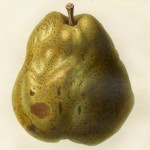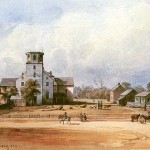Although found in twenty six eastern states, the pawpaw tree might be particularly beloved to Hoosiers for the colloquial names given to its fruit. Known alternately as the “Indiana banana,” or the “Hoosier banana,” the tree Asimina triloba produces the largest edible tree fruit native to the U.S. The only temperate relative of a tropical tree family, the pawpaw tree grows in river bottom land; its mature height of five to ten meters thriving in the forest understory. Growing in clusters, the green-skinned pawpaw fruit offers yellow custard-like flesh with a taste that’s been described as a cross between banana, pineapple and mango. Pawpaw was prized by Native Americans, noted by 16th century European explorers, and integral to the survival of the Lewis and Clark Expedition. Paw Paw township, in Wabash County, Indiana is one of a handful of toponyms from Michigan to West Virginia that honor the once-indispensable fruit.
Beyond mere sustenance, gastronomes since Thomas Jefferson, who cultivated the trees at Monticello, have recognized the fruit’s unique flavor and untapped potential, which has even extended beyond the kitchen. In the 1990s, Purdue scientist Jerry McLaughlin demonstrated that compounds known as acetogenins contained in pawpaw leaf, bark and twig tissue both reduced the growth of cancerous tumors and served as natural pesticides. At the same time, Kentucky State University’s horticulture research program undertook the development of pawpaw as a commercial tree fruit crop. Marketing the fragile fruit for mainstream consumption, however, may be a ways off—the pawpaw’s creamy texture isn’t up to the rigors of long-distance transportation, and the fruit’s large, bean-like seeds are not easily extricated from its pulp. So, for the time being, an elusive fruit occasionally found in abandoned orchards most commonly figures in American culture in the rhythmic, alliterative refrain of a traditional song. “Pickin’ up pawpaws, put ‘em in your pocket…Way Down Yonder in the Paw Paw Patch.”






















